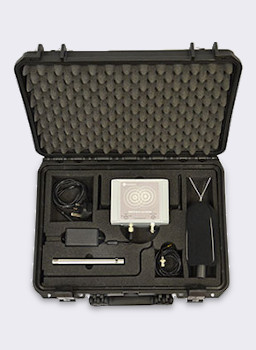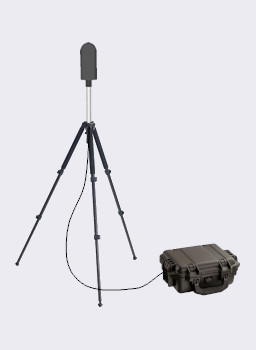


The delivery price is calculated during checkout based on your location and the goods ordered. Our basic delivery prices are:
Delivery within United Kingdom: £12.00 +VAT
Delivery Service: Next working day*
* For products that are in stock and the order received by midday.
Some products go through a final configuration and calibration before being shipped. If the calibration labs are busy this can add up to two days on to the delivery schedule but guarantees a fresh calibration.
The EM2030P is a portable environmental noise monitor that can be easily relocated and left unattended in poor weather conditions. It is enclosed in a weatherproof case and includes an outdoor microphone that can be mounted on a standard tripod (option CT3 if you don't already have one). The monitor connects to the Internet over the mobile phone network, uploading its noise measurements to the cloud server. You just need a web browser and Internet connection to view the noise reports and configure the monitor.
As the EM2030P meets the IEC 61672 to Class 1, the sound levels are measured to the highest standard required by environmental noise regulations and local guidelines.
If you are monitoring at a single location then you may prefer the EM2030 Online Noise Monitor, which includes an extra weatherproof case and installation materials for mounting it more permanently.
Our order code EM2030P/G includes the following:
This basic version of the EM2030P is intended for use in areas where power is available (110V to 240V AC). For use where power is not available you will also need the EMBP2786 battery pack.
The EM2030P connects to the Internet over the mobile phone network (3G / 4G).
The noise monitor sends its noise measurements to the cloud server over this mobile phone link. Your computer does not have to connect to the noise monitor. You view the measurements by visiting the cloud service web site using your usual web browser.
No, the EM2030P comes complete and ready to go, as long as it is in a region with a mobile phone signal. The price includes the first year of your contract, which covers the use of the mobile network (no extra data charges) and access to the cloud service to view noise reports. After the first year you can choose to extend the contract. The price is shown in the Options & Info box above.

The EM2030P is designed to be easily moved between different noise monitoring locations. In its standard form it includes connection to the Internet and online reporting. All it needs is power, somewhere to mount the microphone and a suitable mobile phone network,
Depending on your installation you may also need the following items too:
The measurements will start automatically and be uploaded to the cloud server as they become available.


The microphone comes fitted with weather protection (rain, snow, etc) and a wind shield. It mounts on a stainless steel post which in turn fits on the tripod or other mounting structure. A 10m cable connects the microphone back to the noise processor. This cable can be extended up to 30m using standard RG-174 coaxial cable and suitable connectors.
The batteries are in a separate weatherproof case for easier transport and the option of hot-swapping if you have multiple packs. Noise measurement starts as soon as the battery pack is connected and there is enough power for 10 days operation.

The only tools you need to view the noise reports are:
You can view the measurements, produce reports and download the data to your computer if you need a local copy. This can be done from anywhere, as long as you have a connection to the Internet and the username/password.
Your online account can handle multiple noise monitors. If you have more than one EM2030 (fixed, mobile or mixed) they will all upload their measurements to the same account for easier measurement management.
You can configure multiple projects within the account and assign monitors to these projects. The reporting system is designed to deal with anything from a single noise monitor to multiple monitoring sites.
Guests can be added to your account and given access just to the projects that are of interest to them.
Noise charts show the sound level changes over time. Plotting the LAeq, L90, L10 and Lmax, this example chart clearly shows the day and night sound levels over a few days.
Charts can be printed or exported into PNG, JPEG, PDF or vector format.
A calendar view gives a summary of the average sound level (LAeq) for the period of interest each day. It indicates if the limit has been exceeded on that day.
Clicking on a day provides a more detailed overview, including the noise limit times and a convenient link through to the sound level charts and noise tables.
Results can also be presented on-screen in a simple tabular format.
As with the Noise Chart display, you can select the dates for the chart and, if you have multiple noise monitors, you can select which one to view.
These tables can be exported for custom analysis.
For noise compliance monitoring it can be essential to know about any problems as they occur, rather than looking at a report a few days later. The EM2030 noise monitors and reporting system can be configured to send you a text message or an email alert when an LAeq limit has been exceeded.
With the standard EM2030 alerts can be triggered from the periodic 1 hour LAeq or 15 minute LAeq. If you need more immediate alerts then this is included with the Audio Recording Module EM2030-AG.
The noise charts can be exported to the standard PNG, JPEG and PDF formats for inclusion in any custom reports generated in a word processor or similar application.
Tabular reports can be exported to the standard CSV format, which can be loaded into Excel or many other programs for further analysis and reporting.
A Class 1 Calibrator should be used to check the function of the noise monitor. The Calibrator emits a very accurate 94dB tone at 1kHz and this is used to check the basic function and accuracy of a noise monitor. Some regulations demand the periodic use of a Calibrator.
The standard EM2030P needs mains power to operate, 120V to 240V AC.
The optional EMBP2786 battery pack is supplied in a weatherproof carrying case, similar to the case that carries the noise processor. This allows for easy transport and the ability to swap batteries without opening the Noise Processor - appreciated on rainy days. A charger is also included.
This is a regulated 12V, 40Ah Lithium Iron Phosphate (LiFePO4) with IP67 protection against weather and dust. It weighs 10kg and provides up to 10 days unattended operation for the EM2030P.

The microphone is supplied on a stem that has a threaded base. This can be mounted on a mast or pole for semi-permanent operation.
For portable use it is usually easier to use a heavy duty tripod. We can supply a suitable tripod with order code CT3. You can see the price and add it to your order in the More Options box above.
For a positive identification of the noise source there is no better way than to listen to a recording. With the EM2030-AG option the monitor can be set to record the audio when preset conditions are met (trigger levels, etc). The audio is automatically uploaded to the server so you can listen when viewing the reports. This option also adds the ability to send immediate alerts when a sound level is exceeded.
When you order the EM2030-AG audio option the price includes the mobile connection and reporting contract for the first year. This costs a little more than the non-audio model due to the much larger amount of data involved.
If you are unsure about your need for audio recording then you can buy the standard EM2030P/G and the audio option can be added remotely at a later date.
With the EM2030-O 1/3 octave band filter option fitted the sound level processor splits the spectrum into the standard 30 bands, which are defined by the sound level meter standards. The bands range from 25Hz to 20kHz, more than covering the audible spectrum.
The 1/3 octave band measurements are sent to the cloud server with the rest of the noise measurements for viewing in the online noise reporting system.
| Standards | IEC 61672 Class 1 and ANSI S1.4 Type 1 |
| Mic. Sensitivity | 50mV/pa |
| Mic. Power Supply | Constant current ICP |
| Mic. Connection | BNC to BNC |
| Frequency Weighting | A-weighting and C-weighting |
| Frequency Range | 20Hz to 20kHz |
| 16 to 121 dB(A) | |
| Parameters | Leq, L5, L10, L50, L90, L95, Lmax |
| Measurement Periods | 1, 5, 10, 15 or 30 minutes |
| Data Storage | 5 year (at 5 minute logging) |
| Weatherproof Case | 340 x 300 x 150mm |
| Weight | 3kg |
| Power | 110V to 240V AC to charger |
| 12V to noise monitor | |
| Operating Temperature | -10°C to 50°C |
| Humidity | 0 to 95% |
| Communications | 802.11b/g Wi-Fi and 3G/4G cellular |
As the data handling and report generation is handled by a web server, the computer requirements are very basic. To view the reports online you need the following:
If you want to download the measurements and work with them locally we recommend using Excel or similar spreadsheet. The files are simple CSV text files that will load into many different applications.